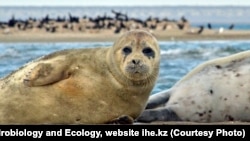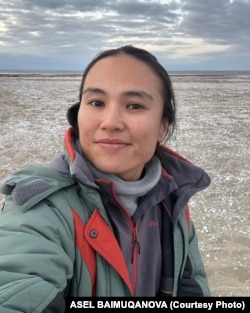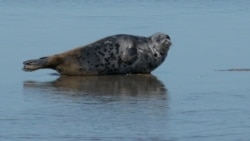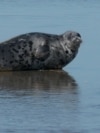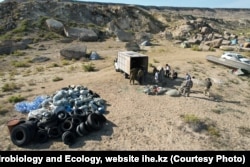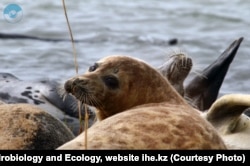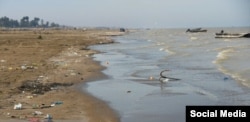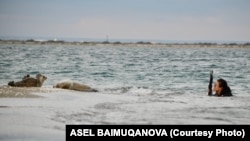As the annual UN climate conference (COP29) takes place in Baku, RFE/RL presents exclusive coverage of environmental issues that are often underreported from regions that are often overlooked.
Asel Baimuqanova has spent a decade trying to learn more about Caspian seals and the reasons for their sharp decline in numbers -- a quest that began with an intimate encounter that left her with sleepless nights.
"I crawled close and saw the seal barely breathing, its neck tangled in a fishing net that cut into its skin," she said.
Baimuqanova had joined international researchers observing seals. She has since been on dozens of expeditions, often spending hours lying motionless in harsh conditions.
"If you lie quietly on the shore, they may let you come close. Within a meter. Once, as I laid there, several seals tried to lay down beside me. I was so happy that they possibly saw me as one of their own. And sometimes, they do their own 'scouting.' You're not the only curious one; they watch you too," Baimuqanova said.
"You establish communication, a connection. It's an extraordinary feeling to which any biologist would relate: when you are in touch with something amazing."
Caspian seals are the only marine mammals in the Caspian Sea and do not live anywhere else.
Once numbering over 1 million in the early 20th century, their population is estimated to have dwindled to between 70,000 and 300,000. The figures are not precise because they have not been closely studied.
Baimuqanova works at the Institute of Hydrobiology and Ecology, a nonprofit organization that is studying whether Caspian seals can adapt to a changing environment.
A mix of factors -- human activity, pollution, climate change, and the shrinking Caspian Sea -- all play a role. The sea's shrinking causes islands to disappear, shift, or merge, forcing seals to find new resting spots.
"In 2009-11, there were the Durneva Islands in the northern Caspian. Up to 25,000 seals would rest there at once. In 2016, about 200 remained. By 2019, only 69. As the sea level dropped, the islands became shallow, and the seals started looking for other places," Baimuqanova said.
"Furthermore, the Caspian experiences cycles where water levels change due to wind patterns. This situation, where resting areas dry up, has always existed. Maybe seals have the ability to adapt to the fluctuations and will continue to survive."
Pollution is another serious threat. Fish, which both humans and seals consume, contain macro- and microplastics.
"In five species, we found these plastics in their stomachs. It's toxic, accumulates in the body, weakens immunity, and can cause diseases," she explained.
In the northeastern Caspian, where seals gather in spring and fall, human impact is relatively low. However, as the sea regresses, the resting spots might shift north, closer to populated areas.
Every spring, ecologists monitor seal mortality on the Tupkaragan Peninsula. There, storms wash ashore animals that died over the winter for various reasons.
Baimuqanova says that year after year, they find seals with mechanical injuries: broken jaws, torn flippers.
"We can only speculate, but perhaps in winter seals get caught under icebreakers' propellers," she said.
Recently, more mass die-offs were recorded in the Kazakh part of the Caspian. At the end of October, 289 dead seals were found along the coast of Manghystau Province. The cause of death is yet to be determined.
Then, on November 11, hundreds more seal carcasses were found, bringing the total number of dead seals in the area to over 1,000, according to official reports.
A similar tragedy that occurred in 2017, when 247 dead seals were found in Kazakhstan, made Baimuqanova seriously consider quitting her work.
"It was hard to look at. You always see them alive, fascinating, and cute. But here they're washed ashore by the hundreds. The stench of decomposition is overwhelming."
Her father, now the head of her organization, supported her.
"He said, 'If you're truly passionate about this, you need to get used to not only the living animals, but also to the dead. Because you need to understand the reasons.'"
The Kazakh government plans to establish a nature reserve of 109,500 hectares in the Manghystau and Atyrau provinces to protect the species, rehabilitate sick animals, and conduct research.
Baimuqanova and her team advocate expanding this area and two years ago developed a detailed plan for seal conservation, but it has not been adopted by the authorities.
Outreach is also a key part of her work. On her Instagram page, Baimuqanova shares stories about her expeditions and the seals.
"Each has its own character. One didn't like us taking samples from it at all. When we released it, it started to 'scold' us, standing in the center of the group of researchers and growling. It didn't calm down until it had confronted each one of us. Then, it turned away from the sea and crawled toward our equipment. I began apologizing, trying to persuade it to return to the sea," Baimuqanova said with a smile.
She tries not to lose her optimism and finds positives even in the hardships of expeditions.
"If it's cold, I make soup with peppers. We bring sweets and coffee. I don't have a sweet tooth, but in such conditions, you crave it. Sitting on a stool by the sea, drinking coffee, eating gingerbread -- it's perfect," she said.
Baimuqanova emphasizes that Kazakhstan's shores are crucial for these animals, with up to 98 percent resting there in spring and autumn.
This proximity, she believes, gives Kazakhstan a special responsibility for their survival.




